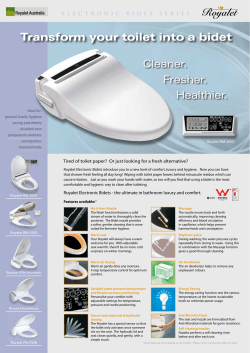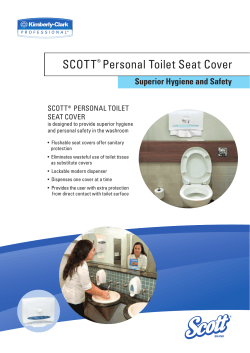
Keep Alabama’s Kids Safe Booster Seats
Standard lap and shoulder belts should not be used for children less than 4’9” tall and weighing less than 80 pounds. Protect your child by using a booster seat. Protect yourself by buckling up. Keep Alabama’s Kids Safe Booster Seats Need Help with Your Car Seat? There are over 20 Child Safety Seat Inspection Stations across Alabama that provide free help and information. To find a certified individual near you, visit www.adph.org/injuryprevention or call 1-800-504-9768 in Alabama. Always read your vehicle’s manual and the safety seat’s instructions to install a car seat correctly. Prepared by Alabama Department of Public Health Injury Prevention Division 201 Monroe Street, Montgomery, AL 36104 (334) 206-5300 / 1-800-252-1818 www.adph.org/injuryprevention 4 STEPS FOR KIDS 1 INFANT ADPH-INJ-18-8-06-kw 2 3 TODDLER BOOSTER SAFETY BELT 4 Most kids age 4 to 8 need booster seats What is a Booster Seat? Less than 10% of children age 4-8 use booster seats. Booster seats ensure the car’s safety belt fits a child correctly. This can avoid serious injury. Car crashes kill more children 4 to 8 years old than anything else. A booster seat is a type of vehicle restraint that lifts children up so that the lap and shoulder harness of a seat belt fits them properly across the hips, chest and shoulder. Seat belts are designed for adults, not children. Beginning at around age 4, many children are too large for toddler seats, but too small for adult safety belts. All children who are 40 pounds and under eight years of age, unless they are 4’9” tall, should be in a booster seat to ensure a proper fit in the vehicle’s seat belt system. (National Highway Traffic Safety Administration) Alabama Child Restraint Law Effective July 1, 2006: Every person transporting a child in a motor vehicle operated on the roadways, streets, or highways of this state, shall provide for the protection of the child by properly using ...a child passenger restraint system. The size appropriate restraint system required for a child shall include all of the following: (1) Birth to Age 1 or 20 pounds: Infant only seats and convertible seats used in the rear facing position. (2) Age 1 or 20 pounds to age 5 or 40 pounds: Convertible seats in the forward position or forward facing seats. (3) Age 5 or 40 pounds to age 6: Booster seats. (4) Age 6 to Age 15: Seat belts. Any person violating the provisions of this act may be fined $25.00. Kids tell us: How the Seat Belt Should Fit: The shoulder belt should cross the child’s chest and rest snugly on the shoulder. The lap belt should rest low across the pelvis or hip area, never across the stomach area. The shoulder belt should never be placed behind a child’s back or under the arm. If this is done, your child could be seriously injured or killed in a crash. How do I know if my child is ready for the seat belt alone? An easy way to tell if your child is ready for a seat belt alone is if the child is tall enough to sit with his or her back against the vehicle seat cushion, with knees bent over the seat edge and feet on the floor, without slouching. The required height for this position is about 4 feet, 9 inches. (American Academy of Pediatrics) “I’m in a big kid seat!” “I can see out the window now!” “The seat belt fits better and doesn’t rub my neck!” Remember: • A booster seat needs to be used every time. • The back seat is the safest place for all children to ride. • Always secure an empty booster seat in place. • Never allow a child to place the shoulder belt behind their back or under their arm.
© Copyright 2025





















